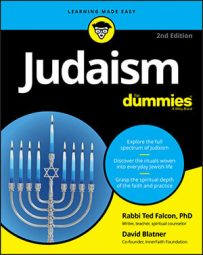Jewish homes are typically similar to other homes in the same neighborhood, inside and out. However, if you keep your eyes open, you may notice a few items that commonly appear in Jewish households. The two most common Jewish items that you may find in a Jewish home are the mezuzah and the menorah.
A literal reading of Deuteronomy 6 says that Jews should post the words of the Sh’ma on their doorposts of their home. A mezuzah is a small container that holds a piece of parchment, on which is written the Sh’ma and two other paragraphs from the books of Deuteronomy and Numbers.
When you buy a mezuzah, you usually have to buy the little parchment separately (a kosher parchment must be written by hand by a trained scribe, so it can cost even more than the mezuzah).
Most folks just put a mezuzah by the entries to the front and back doors of their homes, though traditional Jews place one at about eye level in every doorway in the house, except for the bathrooms and closets.
It’s also the custom to place the mezuzah at an angle, inclined inward, on the right side of the doorpost as you enter. (As the story goes, the rabbis couldn’t decide whether it should be vertical or horizontal, so they decided it should be at an angle to show that compromise is valued in the home.)
Jews say a special blessing when affixing a mezuzah. Once it’s up, they typically touch it with their fingertips, and then kiss their fingertips, each time they enter the house as a sign of reverence and remembrance.
One of the oldest symbols of the Jewish faith, the menorah, was originally the candelabra (well before the invention of candles, of course) in the ancient Temple in Jerusalem. It held seven oil dishes for seven lights, three on each side of one central flame. Although this is still the basic shape of the traditional menorah, the term is often also used for candelabras that hold fewer lights.
Some Jews light a menorah on Shabbat evening; others just use it for a symbol in the house and light the more usual two candles before the Shabbat begins. Often the Chanukkiah, the special eight-lights-plus-a-helper-light-candelabra, is referred to as a Chanukkah menorah.
You may also see other items in a Jewish household. Sometimes a piece of art with the Hebrew word mizrakh (east) hangs on the home’s east wall (facing Jerusalem), and some Jews display their Seder plate in a cabinet.
The Hebrew word chai (life) is a popular symbol in artwork, as is the hamsa, an inverted hand, often with an eye in the middle of the palm. The hamsa is shared with other Middle Eastern cultures and isn’t exclusively Jewish.

